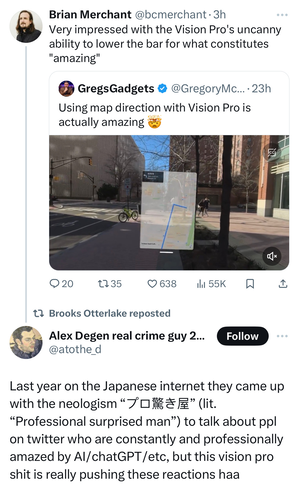Playthings For The Alone
Previously on Icecano: Space Glasses, Apple Vision Pro: New Ways to be Alone.
I hurt my back at the beginning of January. (Wait! This isn’t about to become a recipe blog, or worse, a late-90s AICN movie review. This is gonna connect, bare with me.) I did some extremely unwise “lift with your back, not your knees” while trying to get our neutronium-forged artificial Christmas tree out of the house. As usual for this kind of injury, that wasn’t the problem, the problem was when I got overconfident while full of ibuprofen and hurt it asecond time at the end of January. I’m much improved now, but that’s the one that really messed me up. I have this back brace thing that helps a lot—my son has nicknamed it The Battle Harness, and yeah, if there was a He-Man character that was also a middle-aged programmer, that’s what I look like these days. This is one of those injuries where what positions are currently comfortable is an ever-changing landscape, but the consistant element has been that none of them allow me to use a screen and a keyboard at the same time. (A glace back at the Icecano archives since the start of the year will provided a fairly accurate summary of how my back was doing.)
One of the many results of this is that I’ve been reading way, way more reviews of the Apple Cyber Goggles than I was intending to. I’ve very much been enjoying the early reactions and reviews of the Apple Cyber Goggles, and the part I enjoy the most has been that I no longer need to have a professional opinion about them.
That’s a lie, actually my favorite part has been that as near as I can tell everyone seems to have individually invented “guy driving a cybertruck wearing vision pro”, which if I were Apple I’d treat as a 5-alarm PR emergency. Is anyone wearing these outside for any reason other than Making Content? I suspect not. Yet, anyway. Is this the first new Apple product that “normal people” immediately treated as being douchebag techbro trash? I mean, usually it gets dismissed as overly expensive hipster gear, but this feels different, somehow. Ed Zitron has a solid take on why: How Tech Outstayed Its Welcome.
Like jetpacks and hover cars before it, computers replacing screens with goggles is something science fiction decided was Going To Happen(tm). There’s a sense of inevitability about it, in the future we’re all going to use ski goggles to look at our email. If I was feeling better I’d go scare up some clips, but we’re all picturing the same things: Johnny Mnemonic, any cover art for any William Gibson book, that one Michael Douglas / Demi Moore movie, even that one episode of Murder She Wrote where Mrs. Potts puts on a Nintendo Power Glove and hacks into the Matrix.
(Also, personal sidebar: something I learned about myself the last couple of weeks is somehow I’ve led a life where in my mid-40s I can type “mnemonic” perfectly the first time every time, and literally can never write “johnny” without making a typo.)
But I picked jetpacks and hover cars on purpose—this isn’t something like Fusion Power that everyone also expects but stubbornly stays fifty years into the future, this is something that keeps showing up and turning out to not actually be a good idea. Jetpacks, it turns out, are kinda garbage in most cases? Computers, but for your face, was a concept science fiction latched on to long before anyone writing in the field had used a computer for much, and the idea never left. And people kept trying to build them! I used to work with a guy who literally helped build a prototype face-mounted PC during the Reagan administration, and he was far from the first person to work on it. Heck, I tried out a prototype VR headset in the early 90s. But the reality on the ground is that what we actually use computers for tends to be a bad fit for big glasses.
I have a very clear memory of watching J. Mnemonic the first time with an uncle who was probably the biggest science fiction fan of all time. The first scene where Mr. Mnemonic logs into cyberspace, and the screen goes all stargate as he puts on his ski goggles and flies into the best computer graphics that a mid-budget 1995 movie can muster, I remember my uncle, in full delight and without irony, yelling “that’s how you make a phone call!” He’d have ordered one of these on day one. But you know what’s kinda great about my actual video phone I have in my pocket he didn’t live to see? It just connects to the person I’m calling instead of making me fly around the opening credits of Tron first.
Partly because it’s such a long-established signifier of the future, and lots of various bits of science fiction have made them look very cool, there’s a deep, built-up reservoir of optimism and good will about the basic concept, despite many of the implementations being not-so-great. And because people keep taking swings at it, like jetpacks, face-mounted displays have carved out a niche where they excel. (VR; games mostly, for jetpacks: the opening of James Bond movies.)
And those niches have gotten pretty good! Just to be clear: Superhot VR is one of my favorite games of all time. I do, in fact, own an Oculus from back when they still used that name, and there’s maybe a half-dozen games where the head-mounted full-immersion genuinely results in a different & better experience than playing on a big screen.
And I think this has been one of the fundamental tensions around this entire space for the last 40 years: there’s a narrow band of applications where they’re clearly a good idea, but science fiction promised that these are the final form. Everyone wants to join up with Case and go ride with the other Console Jockeys. Someday, this will be the default, not just the fancy thing that mostly lives in the cabinet.
The Cyber Goggles keep making me thing about the Magic Leap. Remember them? Let me tell you a story. For those of you who have been living your lives right, Magic Leap is a startup who’ve been working on “AR goggles” for some time now. Back when I had to care about this professionally, we had one.
The Leap itself, was pair of thick goggles. I think there was a belt pack with a cable? I can’t quite remember now. The lenses were circular and mostly clear. It had a real steampunk dwarf quality, minus the decorative gears. The central feature was that the lenses were clear, but had an embedded transparent display, so the virtual elements would overlay with real life. It was heavy, heavier than you wanted it to be, and the lenses had the quality of looking through a pair of very dirty glasses, or walking out of a 3D movie without giving the eyewear back. You could see, but you could tell the lenses were there. But it worked! It did a legitimately amazing job of drawing computer-generated images over the real world, and they really looked like they were there, and then you could dismiss them, and you were back to looking at the office through Thorin’s welding goggles.
What was it actually do though? It clearly wasn’t sure. This was shortly after google glass, and it had a similar approach to being a stand-along device running “cut down” apps. Two of them have stuck in my memory.
The first was literally Angy Birds. But it projected the level onto the floor of the room you were in, blocks and pigs and all, so you could walk around it like it was a set of discarded kids toys. Was it better than “regular” angry birds? No, absolutely not, but it was a cool demo. The illusion was nearly perfect, the scattered blocks really stayed in the same place.
The second was the generic productivity apps. Email, calendar, some other stuff. I think there was a generic web browser? It’s been a while. They lived in these virtual screens, rectangles hanging in air. You could position them in space, and they’d stay there. I took a whole set of these screens and arrayed them in the air about and around my desk. I had three monitors in real life, and then another five or six virtual ones, each of the virtual ones showing one app. I could glance up, and see a whole array of summary information. The resolution was too low to use them for real work, and the lenses themselves were too cloudy to use my actual computer while wearing them.
You can guess the big problem though: I coudn’t show them to anybody. Anything I needed to share with a coworker needed to be on one of the real screens, not the virtual ones. Theres nothing quite so isolating as being able to see things no one else can see.
That’s stuck with me all these years. Those virtual screens surrounding my desk. That felt like something. Now, Magic Leap was clearly not the company to deliver a full version of that, even then it was clear they weren’t the ones to make a real go of the idea. But like I said, it stuck with me. Flash forward, and Apple goes and makes that one of the signature features of their cyber goggles.
I can’t ever remember a set of reviews for a new product that were trying this hard to get past the shortcomings and like the thing they were imagining. I feel like most reviews of this thing can be replaced with a clip from that one Simpson’s episode where Homer buys the first hover car, but it sucks, and Bart yells over the wind “Why’d you buy the first hover car ever made?”, to which Homer gleefully responds with “I know! It’s a hover car!” as the car rattles along, bouncing off the ground.
It’s clear what everyone suspected back over the summer is true; this isn’t the “real” product, this is a sketch, a prototype, a test article that Tim Apple is charging 4 grand to test. And, good for him, honestly. The “real” Apple Vision is probably rev 3 or 4, coming in 2028 or thereabouts.
I’m stashing the links to all the interesting ones I read here, mostly so I can find them again. (I apologize to those of you to whom this is a high-interest open tabs balance transfer.)
- Apple Vision Pro review: magic, until it’s not - The Verge
- Apple Vision Pro Review: The Best Headset Yet Is Just a Glimpse of the Future - WSJ
- Daring Fireball: The Vision Pro
- The Apple Vision Pro: A Review
- Michael Tsai - Blog - Apple Vision Pro Reviews
- Apple Vision Pro hands-on, again, for the first time - The Verge
- Hypercritical: Spatial Computing
- Manton Reece - Apple needs a flop
- Why Tim Cook Is Going All In on the Apple Vision Pro | Vanity Fair
- The Apple Vision Pro Is Spectacular and Sad - The Atlantic
- Daring Fireball: Simple Tricks and Nonsense
- All My Thoughts After 40 Hours in the Vision Pro — Wait But Why
But my favorite summary was from Today in Tabs The Business Section:
This is all a lot to read and gadget reviews are very boring so my summary is: the PDF Goggles aren’t a product but an expensive placeholder for a different future product that will hypothetically provide augmented reality in a way that people will want to use, which isn’t this way. If you want to spend four thousand dollars on this placeholder you definitely already know that, and you don’t need a review to find out.
The reviews I thought were the most interesting were the ones from Thompson and Zitron; They didn’t get review units, they bought them with their own money and with very specific goals of what they wanted to use them for, which then slammed into the reality of what the device actually can do:
Both of those guys really, really wanted to use their cyber goggles as a primary productivity tool, and just couldn’t. It’s not unlike the people who tried really hard to make their iPad their primary computer—you know who you are; hey man, how ya doing?—it’s possible, but barely.
There’s a definite set of themes across all that:
- The outward facing “eyesight” is not so great
- The synthetic faces for video calls as just as uncanny valley weird as we thought
- Watching movies is really, really cool—everyone really seems to linger on this one
- Big virtual screens for anything other than movies and other work seems mixed
- But why is this, though? “What’s the problem this is solving?”
Apple, I think at this point, has earned the benefit of the doubt when they launch new things, but I’ve spent the last week reading this going, “so that’s it, huh?” Because okay, it’s the thing from last summer. There’s no big “aha, this is why they made this”.
There’s a line from the first Verge hands-on, before the full review, where the author says:
I know what I saw, but I’m still trying to figure out where this headset fits in real life.
Ooh, ooh, pick me! I know! It’s a Plaything For The Alone.
They know—they know—that headsets like this are weird and isolating, but seem to have decided to just shrug, accept that as the cost of doing business. As much as they pay lip service to being able to dial into the real world, this is more about dialing out, about tuning out the world, about having an experience only you can have. They might not be by themselves, but they’re Alone.
A set of sci-fi sketches as placeholders for features, entertaining people who don’t have anyone to talk to.
My parents were over for the Super Bowl last weekend. Sports keep being cited as a key feature for the cyber goggles, cool angles, like you’re really there. I’ve never in my life watched sports by myself. Is the idea that everyone will have their own goggles for big games? My parents come over with their own his-and-hers headsets, we all sit around with these things strapped to our faces and pass snacks around? Really? There’s no on-court angle thats better than gesturing wildly at my mom on the couch next to me.
How alone do you have to be to even think of this?
With all that said, what’s this thing for? Not the future version, not the science fiction hallucination, this thing you can go out and buy today? A Plaything for the Alone, sure, but to what end?
The consistent theme I noticed, across nearly every article I read, was that just about everyone stops and mentions that thing where you can sit on top of mount hood and watch a movie by yourself.
Which brings me back around to my back injury. I’ve spent the last month-and-change in a variety of mostly inclined positions. There’s basically nowhere to put a screen or a book that’s convenient for where my head needs to be, so in addition to living on ibuprofen, I’ve been bored out of my mind.
And so for a second, I got it. I’m wedged into the couch, looking at the TV at a weird angle, and, you know what? Having a screen strapped to my face that just oriented to where I could look instead of where I wanted to look sounded pretty good. Now that you mention it, I could go for a few minutes on top of Mount Hood.
All things considered, as back injuries go, I had a pretty mild one. I’ll be back to normal in a couple of weeks, no lasting damage, didn’t need professional medical care. But being in pain/discomfort all day is exhausting. I ended up taking several days off work, mostly because I was just to tired to think or talk to anyone. There’d be days where I was done before sundown; not that I didn’t enjoy hanging out with my kids when they got home from school, but I just didn’t have any gas left in the tank to, you know, say anything. I was never by myself, but I frequently needed to be alone.
And look, I’m lucky enough that when I needed to just go feel sorry for myself by myself, I could just go upstairs. And not everyone has that. Not everyone has something making them exhausted that gets better after a couple of weeks.
The question every one keeps asking is “what problem are these solving?”
Ummm, is the problem cities?
When they announced this thing last summer, I thought the visual of a lady in the cramped IKEA demo apartment pretending to be out on a mountain was a real cyberpunk dystopia moment, life in the burbclaves got ya down? CyberGoggles to the rescue. But every office I ever worked in—both cube farms and open-office bullpens—was full of people wearing headphones. Trying to blot out the noise, literal and figurative, of the environment around them and focus on something. Or just be.
Are these headphones for the eyes?
Maybe I’ve been putting the emphasis in the wrong place. They’re a Plaything for the Alone, but not for those who are by themselves, but for those who wish they could be.




